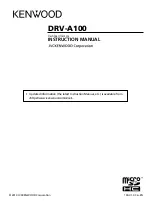
6
VQT2R20
VQT2R20
7
Before use
■
Do a test shot first!
Check first to see if you can take pictures
and record sounds (motion pictures/still
pictures with audio) successfully.
■
We will not compensate for failed/
lost recording or for direct/indirect
damage.
Panasonic will not provide compensation
even if damage is caused by faults with
camera or card.
■
Carefully observe copyright laws.
• Recording of pre-recorded tapes or
discs or other published or broadcast
material for purposes other than your
own private use may infringe copyright
laws. Even for the purpose of private
use, recording of certain material may
be restricted.
■
Avoid shocks, vibration, and pressure.
• Avoid exposing the camera to strong
vibration or shock; e.g. dropping or
hitting the camera, or sitting down with
the camera in your pocket. (Attach
hand strap to avoid dropping camera.
Hanging any items other than the
supplied hand strap from the camera
can apply pressure against it.)
• Do not press the lens or the LCD
monitor.
■
Do not get the camera wet or insert
foreign objects.
This camera is not waterproof.
• Do not expose the camera to water,
rain, or seawater.
(If camera gets wet, wipe with a soft,
dry cloth. Wring cloth thoroughly first if
wet with seawater, etc.)
• Avoid exposing lens and socket to dust
or sand, and do not allow liquids to leak
into gaps around buttons.
■
Avoid condensation caused by sudden
changes in temperature and humidity.
• When moving between places of
different temperature or humidity, place
camera into a plastic bag and allow to
adjust to conditions before use.
• If the lens clouds up, turn off the
camera and leave for about two hours
to allow camera to adjust to conditions.
• If the LCD monitor clouds up, wipe with
a soft, dry cloth.
Read first
To prevent damage, malfunctions, and faults
■
Lens
• If lens is dirty:
Images may appear slightly white if lens
is dirty (fingerprints, etc.).
Turn the power on, hold the extracted
lens barrel with your fingers, and gently
wipe the lens surface with a soft, dry
cloth.
• Do not leave the lens exposed to direct
sunlight.
Camera ON/OFF switch
Do not touch the lens
barrier, as this may
damage lens. Be careful
when removing camera
from bag, etc.
■
When using a tripod or unipod
• Do not apply excessive force or tighten
screws when they are crooked. (This
may damage the camera, screw hole,
or label.)
• Ensure that the tripod is stable. (Refer
to the tripod instructions.)
■
When transporting
Turn off the camera.
Please also refer to ‘Usage cautions and
notes’ (
→
163).
■
Certain pictures cannot be played
back.
• Pictures edited on a computer
• Pictures taken or edited on a different
camera
(Pictures taken or edited on this camera
may also not be able to be played back
on other cameras)
■
Software on the CD-ROM supplied
The following actions are prohibited:
• Making duplicates (copying) for sale
or rent
• Copying onto networks
LCD monitor characteristics
Extremely high precision technology is employed to produce the LCD monitor screen.
However there may be some dark or bright spots (red, blue or green) on the screen.
This is not a malfunction.
The LCD monitor screen has more than 99.99% effective pixels with
a mere 0.01% of the pixels inactive or always lit. The spots will not be
recorded on pictures on the built-in memory or a card.
Grip area
Unit temperature
The surface of the camera (especially the grip area, etc.), the battery
and memory card may become warm during use.
This does not cause a problem with the performance or quality of the
camera.
This manual provides operating instructions for the DMC-ZS7/DMC-ZS6/DMC-ZS5.
The appearance, specifications, and screen display vary depending on the model that is used. The
descriptions in this manual are primarily based on the DMC-ZS7.
Details about functions specific to each model are indicated by symbols added to headings or at
the end of descriptions, etc.
(Example)
Functions available in the DMC-ZS7 only:
Functions available in the DMC-ZS6 only:
Functions available in the DMC-ZS5 only:







































